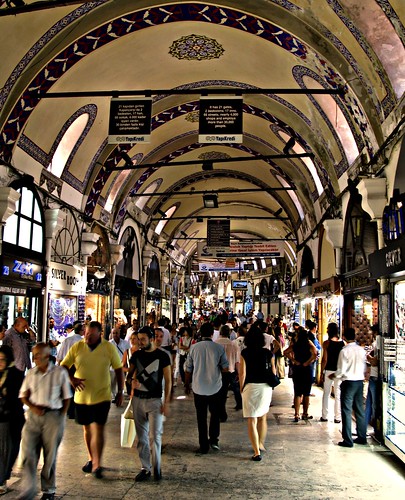by Erincik EDGÜ, Alper ÜNLÜ, Mehmet Emin ŞALGAMCIOĞLU, and Ashkan MANSOURI
Commerce is an ancient economical system that enables establishment of legal and ethical foundations, strengthening of social ties, improving cultural relationships, trading values and technology as well as goods. Trading routes necessitates places for accommodation and rest both for traders and pack animals, horses, camels, oxen and such. For many centuries, caravanserais helped as design solutions for this purpose. However as the stopping places on routes began to act as small trading towns, sarās or hans took over the accommodation service for traders. Although administrative, social, cultural, religious and linguistic distinctions present many functional and semantic variations, having situated on the ancient routes and ports of the Silk Road, cities and states of the west Asia have developed a traditional insight to shopping activity and design that are being preserved in the hearts of these ancient cities.
Although there may be predesigned grid or crisscross exceptions, in most cases, traditional Islamic commercial i.e. shopping spaces are built in time, with expansions in relation to the organic pattern of the city and street layouts. In Turkish social system, covered bazaars are usually built as a part of a larger complex including, hamams, soup kitchens, and such as a source of revenue for mosques, religious or charitable trusts known as vakıfs, where the donated assets cannot be turned over to individuals or institutions. In Iranian system however, covered bazaars are built by state authorities or wealthy individuals solely for the purpose of commerce, although the latter may also include mentioned public amenities. On the other hand, unlike Turkish organisations, having a strong political and/or religious demonstration tradition, Iranian covered bazaars act as a reflection of social indicator. This distinction presents formal variations in layout and attributes semantic uses to spaces as well.
Although sarās or hans were initially used for accommodation purposes in both cultures, they also act a guild for specific branch of trade or manufacturing with their enclosed square/rectangular forms having courtyards or eyvans. However, Iranian bazaar structure relies on linear shopping strips rāstās or arastas combined to compose chārsugs or çarşıs at intersections and meydans serving as the hubs of the network. In Turkish system on the other hand, bedesten, the covered and enclosed core building, where the most expensive and valuable goods are exchanged, determines the formation of the whole bazaar. This building and arastas of the Turkish bazaars are predesigned and built in single sessions without any expansion. Thus, although in both cultures, both organic and pre planned bazaar systems, developed from linear strips are seen, contrary to the articulated and clustered Iranian bazaars, Turkish bazaars formed through connection of arastas acting as gridiron building blocks.
Although there may be predesigned grid or crisscross exceptions, in most cases, traditional Islamic commercial i.e. shopping spaces are built in time, with expansions in relation to the organic pattern of the city and street layouts. In Turkish social system, covered bazaars are usually built as a part of a larger complex including, hamams, soup kitchens, and such as a source of revenue for mosques, religious or charitable trusts known as vakıfs, where the donated assets cannot be turned over to individuals or institutions. In Iranian system however, covered bazaars are built by state authorities or wealthy individuals solely for the purpose of commerce, although the latter may also include mentioned public amenities. On the other hand, unlike Turkish organisations, having a strong political and/or religious demonstration tradition, Iranian covered bazaars act as a reflection of social indicator. This distinction presents formal variations in layout and attributes semantic uses to spaces as well.
Although sarās or hans were initially used for accommodation purposes in both cultures, they also act a guild for specific branch of trade or manufacturing with their enclosed square/rectangular forms having courtyards or eyvans. However, Iranian bazaar structure relies on linear shopping strips rāstās or arastas combined to compose chārsugs or çarşıs at intersections and meydans serving as the hubs of the network. In Turkish system on the other hand, bedesten, the covered and enclosed core building, where the most expensive and valuable goods are exchanged, determines the formation of the whole bazaar. This building and arastas of the Turkish bazaars are predesigned and built in single sessions without any expansion. Thus, although in both cultures, both organic and pre planned bazaar systems, developed from linear strips are seen, contrary to the articulated and clustered Iranian bazaars, Turkish bazaars formed through connection of arastas acting as gridiron building blocks.
This research focuses on the comparison of the physical layout of Iranian and Turkish traditional covered bazaars in the context of Tabriz and Istanbul respectively. The usage of gathering spaces, articulation of nodes, connection of main or secondary axes in forms of hans, bedestens, eyvans, courtyards, meydans with streets or arastas and such, are the syntactic experiment areas of the research. The research hypothesis assumes that guild formation affects the articulation and spatial configuration of the spaces that in return changes the usage in terms of social gatherings versus pedestrian flow in the traditional covered bazaars.

more about Space Syntax:
No comments:
Post a Comment